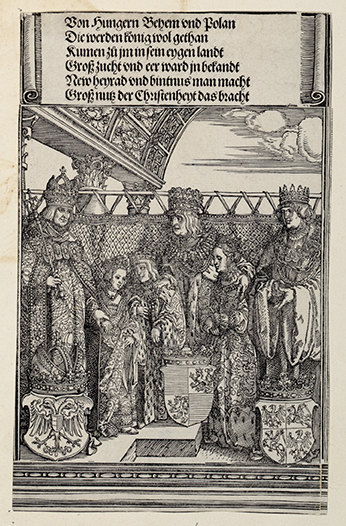Wedding festivities
In the days preceding and following the wedding ceremony on 22nd July, the visiting members of the House of Jagiellon – not only King Vladislaus and his children, but also his brother Sigismund, King of Poland – were introduced to all kinds of revels and musical practices of Maximilian’s court: hunts, banquets, jousts and dances all took place during this period. At the wedding ceremony itself, the Cardinal of Esztergom pronounced a general indulgence in his own name and that of Cardinal [Matthäus Lang] of Gurk, to which Maximilian’s chapel choir simultaneously sang the Te Deum, accompanied by stringed and wind instruments (“mit allen saitenspiln aufgeblasen”); the great organist Paul Hofhaimer “responded” on the organ.[20] The Chapelmaster of the Emperor and Bishop of Vienna, Georg Slatkonia celebrated the solemn service, which was carried out “with the most exquisite music of various musical performers.”[21]
The Vienna double wedding was thus not only an event of great political significance for the future of the Habsburg Empire, it also provided the opportunity for a contrasting display of musical practices and instruments from across the Habsburg and Jagiellonian lands. Besides the other instruments present, it was the most prestigious instrument of all – the trumpet – which added particular splendour to the proceedings. The numerous persons – including musicians – present, as well as the diverse entertainments that followed the royal entries described above, clearly testify to the great importance of the wedding, not only to Emperor Maximilian and King Vladislaus, but for future generations of their royal houses.
[20] Der namhaftigen Kay. Ma. Und dreyer Kunigen, fol. 13r; Nowak 1932, 85. Hofhaimer was amongst the many who received knighthoods on this occasion.
[21]Der namhaftigen Kay. Ma. und dreyer Kunigen, fol. 13r; Nowak 1932, 84.
[1] For further details of the background to this alliance, see Wiesflecker 1999, 392 ff.
[3] See Nowak 1932, 72 ff., and Müller 2015, on Cuspinian’s Diarium.
[4] Newe zeitung, fol. 4v; in Nowak 1932, 80, “Drummers” is given as a common designation for players of “heerpaucken”, actually kettledrums.
[5] Der namhaftigen Kay. Ma. und dreyer Kunigen, fol. 11r; Nowak 1932, 82.
[6] Die verainigung Kaiserlicher Ma., fol. 4r; Nowak 1932, 81.
[7] Newe zeitung, fol. 5r; Nowak 1932, 81.
[8] For further details of this procession see Nowak 1932, 80 ff.
[10] Newe zeitung, fol. 2r. This and the following nine notices are also assembled in Nowak 1932, 78 f.
[11] Die verainigung Kaiserlicher Ma., fol. 2v.
[12] Der namhaftigen Kay. Ma. und dreyer Kunigen, fol. 8r.
[13] Wo und wie Römische. Kaiserliche. Maiestat, fol. 2v.
[14] Newe zeitung, fol. 2v.
[15] Newe zeitung, fol. 3r.
[16] Der namhaftigen Kay. Ma. und dreyer Kunigen, fol. 9r.
[17] Newe zeitung, fol. 3r.
[18] Newe zeitung, fol. 3v.
[19] Der namhaftigen Kay. Ma. und dreyer Kunigen, fol. 9v.
[20] Der namhaftigen Kay. Ma. Und dreyer Kunigen, fol. 13r; Nowak 1932, 85. Hofhaimer was amongst the many who received knighthoods on this occasion.
[21]Der namhaftigen Kay. Ma. und dreyer Kunigen, fol. 13r; Nowak 1932, 84.
Empfohlene Zitierweise:
Helen Coffey: “Music for a Royal Entry: The Vienna Double Wedding of 1515”, in: Musikleben des Spätmittelalters in der Region Österreich <https://musical-life.net/essays/music-royal-entry-vienna-double-wedding-1515> (2016).
